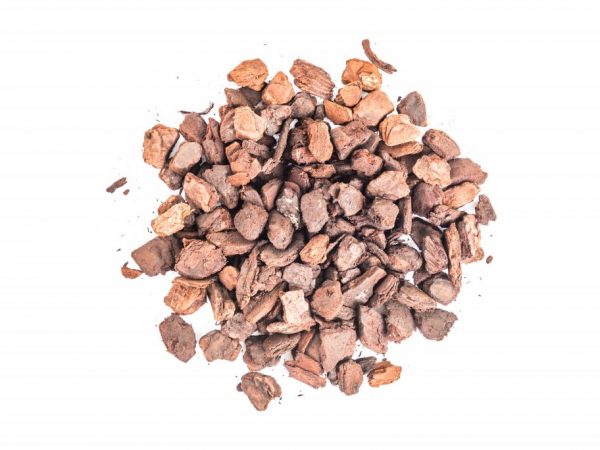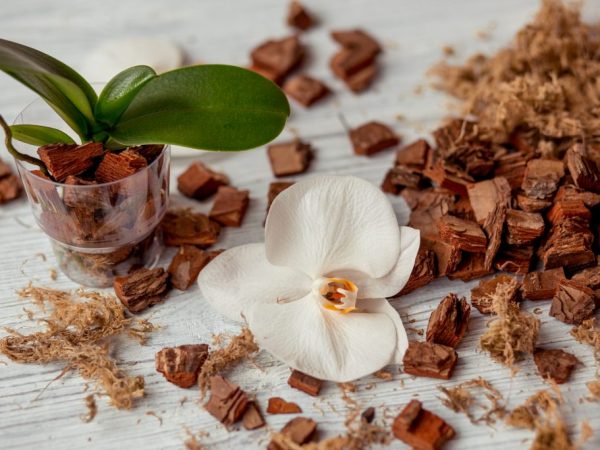Preparing the bark for orchids
In the wild, orchids attach themselves to the bark of trees and extract nutrients with aerial roots. When growing at home, an orchid is provided with conditions close to natural. Orchid tree bark serves as a suitable substrate. It is chemically inert, breathable and retains moisture when watering.

Preparing the bark for orchids
Substrate composition
When planting orchids, use a purchased substrate (biomixture).
Often stale soil is found in stores, the qualities of which have suffered over time. Decorative flowers are not planted in it: this threatens with drying out or rotting of the roots.
Florists who have been growing orchids at home for a long time prepare the mixture with their own hands using the following components:
- pine wood;
- sphagnum (freshly harvested marsh moss);
- crushed activated carbon;
- Pine cones.
Self-mixed soil from the listed components is used for growing at home varieties of phalaenopsis, dendrobium and their hybrids. They feed only on aerial roots and do not require fertile deciduous soil as part of the soil. The primer is suitable for exotic flowers in open and closed systems.
Not only pine bark can be used for orchids. Birch bark, oak or spruce wood are suitable, but delamination is rare in trees. The fallen bark of larch, thuja and cypress is often used in the preparation of store mixes.
Wood forms an inert and breathable base of the soil. Thanks to phytoncides, parasites do not start in the substrate. Cones are an auxiliary part of the soil, but they are not always used. The scales are separated from each other, kept for 5-7 minutes. in hot water, dried and added to the mixture.
Sphagnum absorbs and retains water well, maintains the integrity of the soil mixture. Activated carbon serves a direct purpose. The component draws toxic substances from soil and water.
Peat is also added to the substrate for young plants: they require an increased content of nutrients. Some varieties require perlite, broken brick and river sand.
Which wood is suitable
Not every pine bark is a good substrate for orchids. Florists recommend collecting bark only from felled or dried pine trees.
Resin is contained in the wood of living pine in high concentrations. This component is not suitable for phalaenopsis. Dead parts are more difficult to remove from the trunk, but they are practically devoid of resinous substances.
It is allowed to use wood if it meets the requirements:
- breaks easily in hands: this indicates a small amount of resins;
- has a uniform color without burnt spots;
- has a homogeneous structure without rotten or rotten areas.
Oak or other softwood must also meet the requirements.
It is recommended to cut or break off only the top layer of the bark.All areas with a burnt out color (darkened), rotten structure are removed from the material. Rotten material is not used at all, putrefactive bacteria quickly spread in the wood and harm the plant for which it serves as a substrate. Dust and insects are immediately removed from the collected material.
Where to find and how to collect the substrate
Preparing the bark for planting orchids begins with finding the right raw material. Pine wood is harvested in a pine forest, planting, in the park. The collection point should be far from busy highways, chemical, metallurgical, oil refineries. The bark is cut with a sharp penknife from fallen trees or stumps.
Sphagnum is collected in the forest in low-lying wet areas, and moss is also found near water bodies. Only fresh and green plants are harvested.
The substrate is easy to find at the sawmill. You don't even have to collect it there. The top dry layers fall off the trunk on their own during sawing or other processing. The material is also inspected for compliance.
How to properly prepare the substrate

The bark needs to be prepared for use
Do-it-yourself preparation of the bark for orchids includes the rejection of low-quality material, additional drying and heat treatment. During drying and heat treatment, adult parasites, larvae and eggs die in the material.
An oven is used for thermal drying. It is heated to 120 ° C, the wood is left for 5-10 minutes. The biomaterial is recommended to be cooked when preparing a mixture at home. Before boiling, the wood is crushed. Small pieces are easier to boil and dry faster, the effect of this procedure is better.
Heat treatment of pine bark for orchids is carried out in galvanized buckets. The material is placed on the bottom and pressed down with something heavy. The bucket is not filled to the top with liquid. The distance from the water surface to the edges of the bucket should be 5-10 cm. The chopped wood is boiled over low heat for an hour. Then they allow the liquid to cool, and the resinous carbon deposits are removed from the warm bucket (dry resin is difficult to scrape off). The contents of the bucket are poured into a colander, the moisture gradually drains away. This does not end with the processing of the substrate.
Dried bark for orchids with your own hands is crushed with a disinfected sharp knife. For young seedlings, the parameters of the fractions are 1: 1 cm, for adults - 1: 1.5 cm. The chopped pieces are kneaded with your fingers so that the edges become less sharp.
For drying, the substrate is divided into several piles, folded in thin paper bags to protect it from dust and insects. If white mold develops on pine wood during storage, it is not required to reanimate the material by boiling. Plants in the wild enter into symbiosis with fungi.
Sphagnum is also required to prepare for planting and transplanting plants. It is recommended to soak it in clean water with the addition of a few potassium permanganate granules.
Pine wood is suitable for long-term storage for 2-3 years. It is recommended to prepare it in advance for transplanting young plants, which is carried out annually.
Planting a plant
It is not enough to prepare the bark for orchids, you need to properly plant the plant and take care of it at home. For flowers, use transparent pots with a large number of holes in the bottom (open system) or glass containers, narrowed at the bottom and widened at the top. Before transplanting the plant, the container is treated with a weakly colored solution of potassium permanganate.
Planting stages:
- the bottom of the pot is covered with drainage a quarter of the height (expanded clay, brick chips are suitable);
- put the plant in a pot;
- carefully cover the orchid with the prepared substrate, the largest fragments of wood are placed in the lower layers.
The plant should adhere tightly to the substrate, not wobble.
In care, tropical plants are not capricious. They are sprayed with clean water 2-3 times a week, watered once a week.Top dressing is applied only in summer. Transplanting the plant during flowering is prohibited.
Conclusion
It is not difficult to prepare coniferous wood for an orchid on your own, but it is a responsible task. The material must be of high quality so as not to harm the plant. When planting, mix the new soil with a small amount of the old one in order to preserve the familiar microflora.


